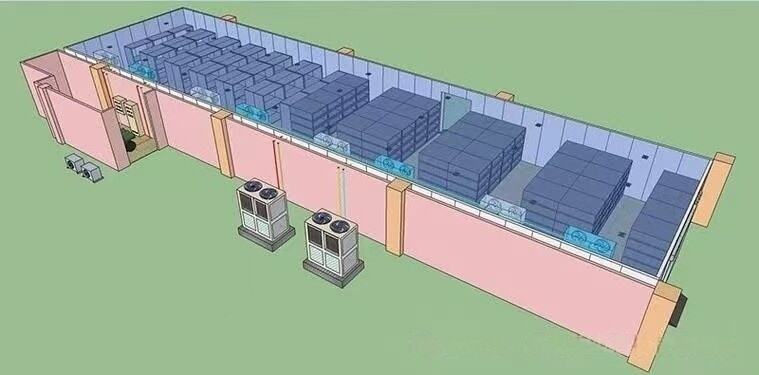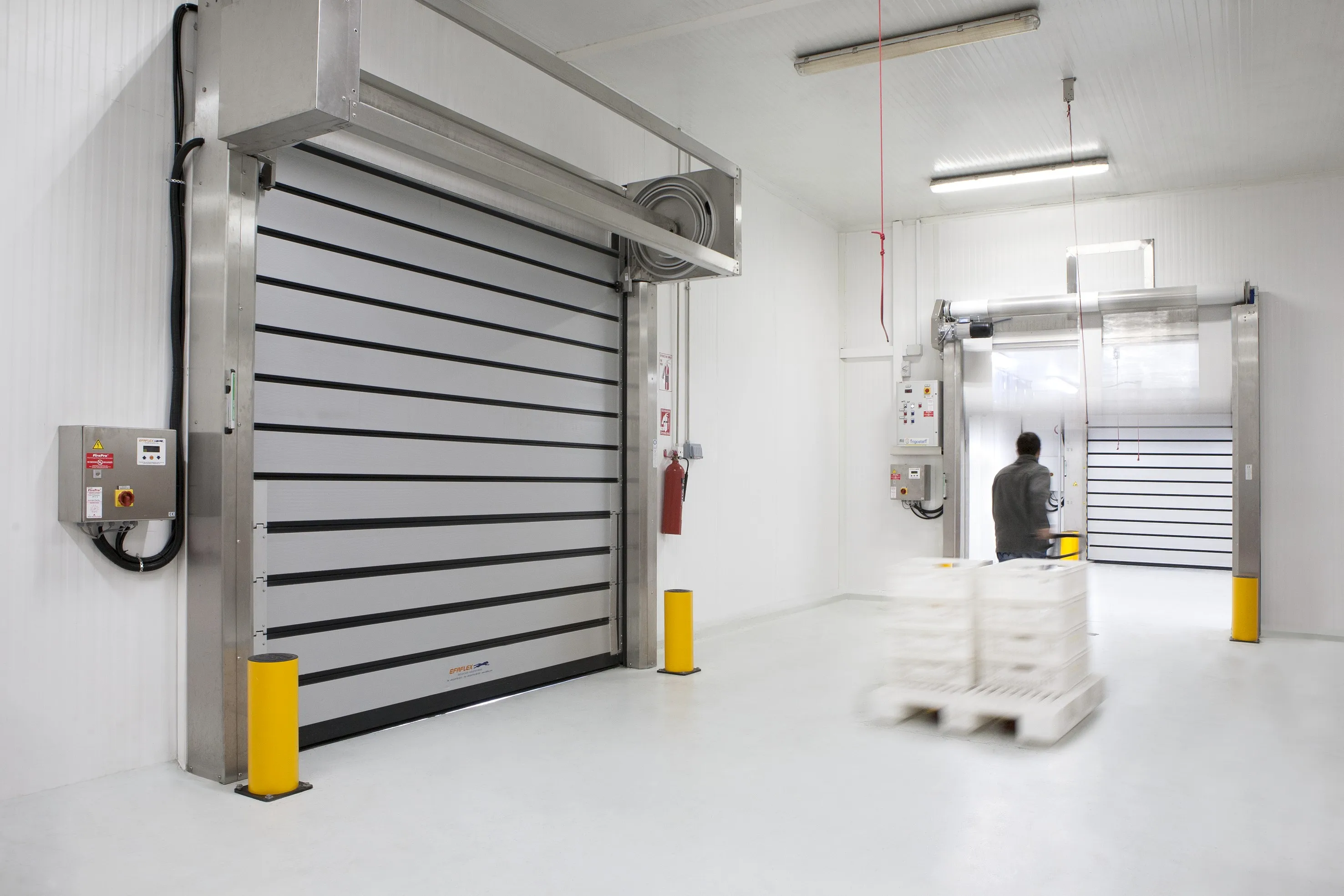The Science Behind Cold Room Technology and Modern Food Preservation
How Cold Room Technology Enhances Shelf Life and Food Safety
Cold storage rooms keep food fresh longer because they slow down those pesky enzymes and stop bacteria from multiplying so fast. When kept at around freezing point to just above, these cool spaces cut down on bad bacteria growth by almost three quarters when compared with regular fridges according to research published last year in Food Safety Journal. Take spinach or kale for instance stored this way stays much juicier and holds onto its vitamins better too. Tests showed that after two weeks in cold storage, these greens still had about half again as much vitamin C left compared to what happens in normal fridge conditions where oxidation eats away at nutrients faster. Newer models now come with special coatings that fight germs plus automatic cleaning features which tackle most of the problems people face with old fashioned storage methods where different foods get mixed up and spread contaminants around.
Controlled and Dynamic Atmospheric Storage (CA/ULO, DCA) Explained
CA and DCA tech work wonders for extending how long produce stays fresh by tweaking oxygen levels between 1-5% and carbon dioxide around 3-10%. These adjustments basically slow down the ripening process and stop mold from taking hold. Take ULO storage as another example. When apples are kept in ultra low oxygen conditions, they can last anywhere from six to eight months longer because there's much less ethylene gas being produced naturally. The newer DCA systems go even further though. They actually have sensors that monitor what fruits are doing in real time, then adjust the atmosphere accordingly. This dynamic approach has been shown to cut down on wasted citrus crops by about a third according to recent studies from the Post Harvest Tech folks in 2024.
Extending Shelf Life Through Precise Temperature and Humidity Control
| Factor | Optimal Range | Impact on Shelf Life |
|---|---|---|
| Temperature | ±0.5°C | Prevents ice crystallization in proteins |
| Relative Humidity | 85–95% | Reduces dehydration by 70% in meats |
| Airflow | 0.2–0.5 m/s | Eliminates microclimate variations |
Multi-zone cold rooms equipped with AI-driven sensors maintain these parameters with 99.8% accuracy, extending berry freshness by 21 days. Adaptive defrost cycles further reduce energy waste by 18%, enhancing both efficiency and product quality.
Smart Monitoring and IoT Integration for Real-Time Cold Chain Management

Refrigeration Systems with IoT Integration for Real-Time Monitoring
IoT-enabled refrigeration systems continuously monitor temperature, humidity, and energy usage, automatically adjusting cooling based on live data to ensure compliance and minimize human error. These advancements are driving the global food cold chain market toward an estimated $5.5 billion by 2030 (ABI Research, 2024).
Sensor-Based and Smart Technologies for Advanced Cold Storage Management
High-precision sensors detect temperature fluctuations as small as 0.5°C, triggering immediate alerts to prevent spoilage. Industry leaders report a 45% reduction in spoilage incidents and 20–30% gains in energy efficiency through intelligent humidity and airflow management. Integrated with inventory platforms, these systems automate stock rotation, reducing waste and improving traceability.
Remote Monitoring Capabilities Improve Operational Efficiency
Cloud-based dashboards enable centralized oversight of multiple facilities, cutting manual inspections by up to 70%. Real-time diagnostics support predictive maintenance, reducing equipment downtime by 40% and extending service life. This level of visibility is essential for large-scale operations, where even brief temperature excursions can compromise entire shipments.
Energy-Efficient and Sustainable Cold Room Design Innovations
Modern cold rooms combine advanced materials and renewable energy integration to achieve high performance with lower environmental impact. These innovations reduce energy consumption by up to 40% compared to conventional designs while ensuring optimal preservation conditions.
Advanced Insulation Technologies: Vacuum Insulated Panels and Their Impact
Vacuum insulated panels (VIPs) offer thermal resistance 5–8 times greater than standard foam insulation. By drastically reducing heat transfer through walls and ceilings, VIPs lower refrigeration workloads by 25–30%, translating into significant energy and cost savings—especially in large-scale facilities where temperature stability directly affects food safety and shelf life.
Phase Change Materials (PCMs) for Stable Temperature Regulation
Phase change materials absorb excess heat during cooling cycles and release it during fluctuations, stabilizing temperatures without over-relying on compressors. Bio-based PCMs can maintain storage conditions within ±0.5°C during power outages, making them vital for preserving sensitive goods like pharmaceuticals and delicate produce.
Reducing Carbon Footprint Through Eco-Friendly Refrigerants
The shift to low-global warming potential (GWP) refrigerants such as CO₂ and ammonia has cut direct emissions by 78% since 2020. According to a 2025 industry analysis, 58% of new installations now use these eco-friendly alternatives, aligning with the EPA’s 2030 net-zero goals for commercial refrigeration.
Solar-Powered and Energy-Efficient Cold Storage Solutions
Hybrid solar-powered systems with battery storage can offset 60–90% of grid energy demand in regions with high solar exposure. These setups provide reliable backup during outages and reduce fossil fuel dependence—particularly beneficial for agricultural cooperatives storing seasonal harvests in remote or off-grid areas.
Automation and AI-Driven Precision in Cold Room Operations
AI and Digital Platforms for Cold Chain Coordination and Quality Monitoring
Platforms powered by artificial intelligence are making supply chains clearer and products more trustworthy through analysis of data collected from those little IoT sensors everywhere these days. The machine learning stuff behind them can spot when temperatures start going off track, figure out when machines might fail before they actually do, and even tweak storage conditions without anyone having to lift a finger. According to some industry numbers from 2025, places that implemented these smart systems saw about 27 percent less food getting spoiled. Plus there's all this automatic paperwork generation for things like humidity levels, how long items stay chilled, and whether cleaning standards were met properly. Not bad for technology that wasn't around twenty years ago.
Automation in Inventory and Climate Control Systems
Automated storage and retrieval systems (AS/RS) and robotic pallet handlers streamline operations in subzero environments. Key advancements include:
- Robotic arms that move perishables between zones without disrupting temperature
- Dynamic airflow systems that modulate cooling based on real-time product density scans
- Ice-detection sensors that trigger automated defrost cycles only when needed
These innovations reduce human intervention by 63% in high-volume facilities while maintaining uniform storage conditions.
Balancing High Initial Investment with Long-Term Operational Savings

Although automated cold rooms entail 30–50% higher upfront costs, they typically achieve ROI within 3–5 years through:
- 45% lower energy use via AI-optimized compressor operation
- 90% fewer temperature-related insurance claims
- 70% reduced staffing needs due to 24/7 automation
Facilities combining automation with phase-change materials report an 18% increase in produce shelf life, directly lowering waste and boosting profitability.
Hygienic Design and Global Impact on Food Quality and Loss Reduction
Modern cold rooms are engineered with contamination-resistant features such as seamless, crevice-free surfaces and antimicrobial coatings that inhibit bacterial growth—principles supported by hygiene control research. Automated sanitization routines and controlled airflow further prevent cross-contamination while preserving texture and nutrition.
Design Features That Prevent Contamination and Maintain Freshness
Sealed door gaskets, corrosion-resistant alloys, and sloped flooring allow thorough cleaning and withstand high-pressure washing. These design elements minimize microbial harborage points, reducing foodborne pathogen risks by up to 62% compared to conventional storage (Food Safety Report 2024).
Case Study: Reducing Post-Harvest Losses in India with Advanced Cold Rooms
A 2024 pilot program in India’s Punjab region deployed modular cold rooms across 120 farms, reducing post-harvest losses of tomatoes and potatoes from 35% to 9%. The initiative increased smallholder farmer incomes by 27% and improved market access for perishable crops, demonstrating the transformative potential of modern cold storage in developing economies.
FAQ
What is the benefit of using Controlled and Dynamic Atmospheric Storage?
Controlled and Dynamic Atmospheric Storage extends the freshness of produce by adjusting oxygen and carbon dioxide levels to slow down ripening and prevent mold.
How do IoT-enabled refrigeration systems improve cold chain management?
IoT-enabled systems monitor temperature and humidity in real-time, ensuring precise control to reduce spoilage and energy usage.
What are the advantages of using advanced insulation technologies in cold rooms?
Advanced insulation technologies like Vacuum Insulated Panels greatly reduce heat transfer, decreasing refrigeration workload and saving energy.
How does AI contribute to reducing food spoilage in cold storage?
AI analyzes data from IoT sensors to predict temperature deviations and equipment failures, optimizing storage conditions automatically to reduce food spoilage.
Table of Contents
- The Science Behind Cold Room Technology and Modern Food Preservation
- Smart Monitoring and IoT Integration for Real-Time Cold Chain Management
- Energy-Efficient and Sustainable Cold Room Design Innovations
- Automation and AI-Driven Precision in Cold Room Operations
- Hygienic Design and Global Impact on Food Quality and Loss Reduction
- FAQ

